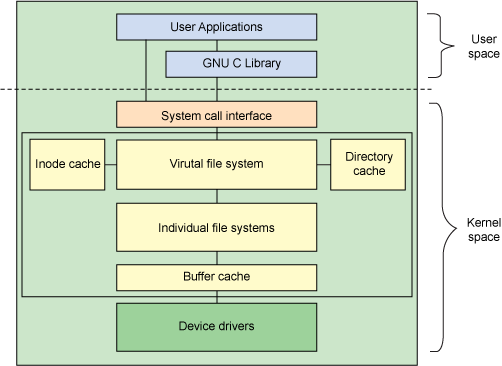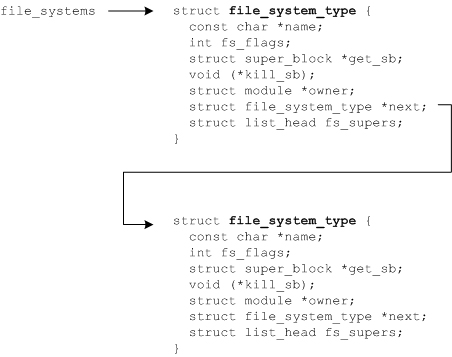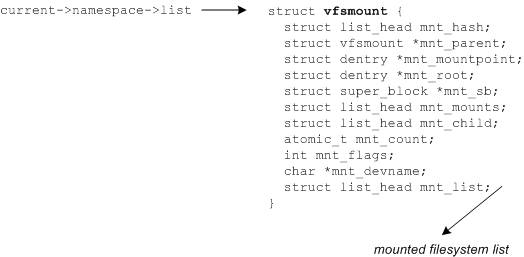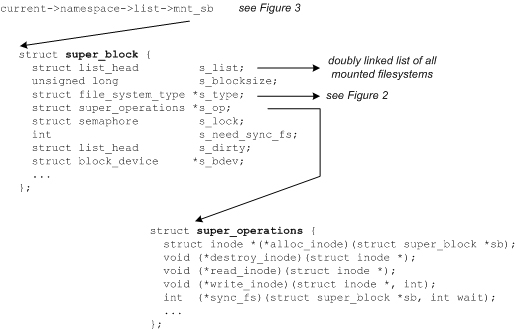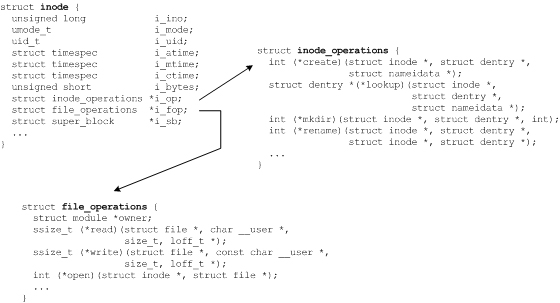关键词:
嵌入式 Linux根文件系统移植(一)——Linux文件系统简介
本文对文件系统分析的代码来源于linux 2.6.35.7版本。
一、文件系统的体系结构
文件系统是对存储设备上的数据和元数据进行组织的机制,便于用户和操作系统的交互。Linux支持多种文件系统,文件系统接口实现为分层的体系结构,将用户接口层、文件系统实现和操作存储设备的驱动程序分隔开。Linux文件系统的体系结构如下:
用户空间包含一些应用程序(例如,文件系统的使用者)和 GNU C库(glibc),为文件系统调用(打开、读取、写和关闭)提供用户接口。系统调用接口的作用就像是交换器,将系统调用从用户空间发送到内核空间中的适当端点。
VFS 是底层文件系统的主要接口,会导出一组接口,抽象到各个文件系统。有两个针对文件系统对象的缓存(inode 和 dentry),用于缓存最近使用过的文件系统对象。
每个文件系统的实现(比如 ext2、yaffs2等等)导出一组通用接口,供VFS使用。缓冲区缓存会缓存文件系统和相关块设备之间的请求。例如,对底层设备驱动程序的读写请求会通过缓冲区缓存来传递,允许在缓冲区缓存请求,减少访问物理设备的次数,加快访问速度。以最近使用(LRU)列表的形式管理缓冲区缓存。但是,可以使用sync命令将缓冲区缓存中的请求发送到存储媒体(迫使所有未写的数据发送到设备驱动程序,进而发送到存储设备)。
二、虚拟文件系统层
VFS 作为文件系统接口的根层。VFS 记录当前支持的文件系统以及当前挂装的文件系统。VFS并不是一种实际的文件系统,只存在于内存中,不存在于任何外存空间。VFS在系统启动时建立,在系统关闭时消亡。
可以使用一组注册函数在Linux中动态地添加或删除文件系统。kernel保存当前支持的文件系统的列表,可以通过 /proc 文件系统在用户空间中查看这个列表。proc虚拟文件系统还显示当前与所支持文件系统相关联的设备。在Linux中添加新文件系统的方法是调用register_filesystem,函数的参数定义一个文件系统结构(file_system_type)的引用,文件系统结构定义了文件系统的名称、一组属性和两个超级块函数。register_filesystem函数也可以注销文件系统。
在注册新的文件系统时,会把要注册的新文件系统及其相关信息添加到 file_systems链表中(linux/include/linux/fs.h)。file_systems列表定义可以支持的文件系统。在命令行上输入cat /proc/filesystems,就可以查看当前linux系统支持的文件系统类型。
int register_filesystem(struct file_system_type * fs)
{
int res = 0;
struct file_system_type ** p;
BUG_ON(strchr(fs->name, ‘.‘));
if (fs->next)
return -EBUSY;
INIT_LIST_HEAD(&fs->fs_supers);
write_lock(&file_systems_lock);
p = find_filesystem(fs->name, strlen(fs->name));
if (*p)
res = -EBUSY;
else
*p = fs;
write_unlock(&file_systems_lock);
return res;
}struct file_system_type {
const char *name;
int fs_flags;
int (*get_sb) (struct file_system_type *, int,
const char *, void *, struct vfsmount *);
void (*kill_sb) (struct super_block *);
struct module *owner;
struct file_system_type * next;
struct list_head fs_supers;
struct lock_class_key s_lock_key;
struct lock_class_key s_umount_key;
struct lock_class_key s_vfs_rename_key;
struct lock_class_key i_lock_key;
struct lock_class_key i_mutex_key;
struct lock_class_key i_mutex_dir_key;
struct lock_class_key i_alloc_sem_key;
};VFS 中维护的另一个结构是挂载的文件系统,提供当前挂载的文件系统(见 linux/include/linux/mount.h),链接超级块结构。
struct vfsmount {
struct list_head mnt_hash;
struct vfsmount *mnt_parent;/* fs we are mounted on */
struct dentry *mnt_mountpoint;/* dentry of mountpoint */
struct dentry *mnt_root;/* root of the mounted tree */
struct super_block *mnt_sb;/* pointer to superblock */
struct list_head mnt_mounts;/* list of children, anchored here */
struct list_head mnt_child;/* and going through their mnt_child */
int mnt_flags;
const char *mnt_devname;/* Name of device e.g. /dev/dsk/hda1 */
struct list_head mnt_list;
struct list_head mnt_expire;/* link in fs-specific expiry list */
struct list_head mnt_share;/* circular list of shared mounts */
struct list_head mnt_slave_list;/* list of slave mounts */
struct list_head mnt_slave;/* slave list entry */
struct vfsmount *mnt_master;/* slave is on master->mnt_slave_list */
struct mnt_namespace *mnt_ns;/* containing namespace */
int mnt_id;/* mount identifier */
int mnt_group_id;/* peer group identifier */
atomic_t mnt_count;
int mnt_expiry_mark;/* true if marked for expiry */
int mnt_pinned;
int mnt_ghosts;
#ifdef CONFIG_SMP
int __percpu *mnt_writers;
#else
int mnt_writers;
#endif
};三、文件的结构
VFS对Linux的每个文件系统的所有细节进行抽象,使得不同的文件系统在Linux核心以及系统中运行的其他进程看来,都是相同的,这种抽象的结构就是通用文件模型,由超级块(superblock)、inode、dentry 和文件组成。超级块在每个文件系统的根上,用于描述和维护文件系统的状态。文件系统中管理的每个文件(文件、目录、设备,linux中一切皆是文件)在 Linux 中表示为一个 inode。inode 包含管理文件系统中的文件所需的所有元数据(包括可以在文件上执行的操作)。dentry用来实现文件名称和inode之间的映射,有一个目录缓存用来保存最近使用的dentry。dentry还维护目录和文件之间的关系,从而支持文件在文件系统中移动。VFS文件表示一个打开的文件(保存打开的文件的状态,比如写偏移量等等)。
1、超级块
超级块结构表示一个文件系统,包含管理文件系统所需的信息,包括文件系统名称(比如 ext2)、文件系统的大小和状态、块设备的引用和元数据信息(比如空闲列表等等)。超级块通常存储在存储媒体上,但是如果超级块不存在,也可以实时创建它。可以在 ./linux/include/linux/fs.h 中找到超级块结构。
struct super_block {
struct list_heads_list;/* Keep this first */
dev_ts_dev;/* search index; _not_ kdev_t */
unsigned chars_dirt;
unsigned chars_blocksize_bits;
unsigned longs_blocksize;
loff_ts_maxbytes;/* Max file size */
struct file_system_type*s_type;
const struct super_operations*s_op;
const struct dquot_operations*dq_op;
const struct quotactl_ops*s_qcop;
const struct export_operations *s_export_op;
unsigned longs_flags;
unsigned longs_magic;
struct dentry*s_root;
struct rw_semaphores_umount;
struct mutexs_lock;
ints_count;
atomic_ts_active;
#ifdef CONFIG_SECURITY
void *s_security;
#endif
const struct xattr_handler **s_xattr;
struct list_heads_inodes;/* all inodes */
struct hlist_heads_anon;/* anonymous dentries for (nfs) exporting */
struct list_heads_files;
struct list_heads_dentry_lru;/* unused dentry lru */
ints_nr_dentry_unused;/* # of dentry on lru */
struct block_device*s_bdev;
struct backing_dev_info *s_bdi;
struct mtd_info*s_mtd;
struct list_heads_instances;
struct quota_infos_dquot;/* Diskquota specific options */
ints_frozen;
wait_queue_head_ts_wait_unfrozen;
char s_id[32];/* Informational name */
void *s_fs_info;/* Filesystem private info */
fmode_ts_mode;
u32 s_time_gran;
struct mutex s_vfs_rename_mutex;/* Kludge */
char *s_subtype;
char *s_options;
};超级块中的一个重要元素是超级块操作的定义super_operations,super_operations结构定义一组用来管理文件系统中的 inode 的函数。例如,可以用alloc_inode分配 inode,用destroy_inode删除inode。可以用read_inode和 write_inode读写inode,用sync_fs执行文件系统同步。可以在 /linux/include/linux/fs.h 中找到 super_operations 结构。每个文件系统提供自己的inode方法,这些方法实现操作并向 VFS 层提供通用的抽象。
struct super_operations {
struct inode *(*alloc_inode)(struct super_block *sb);
void (*destroy_inode)(struct inode *);
void (*dirty_inode) (struct inode *);
int (*write_inode) (struct inode *, struct writeback_control *wbc);
void (*drop_inode) (struct inode *);
void (*delete_inode) (struct inode *);
void (*put_super) (struct super_block *);
void (*write_super) (struct super_block *);
int (*sync_fs)(struct super_block *sb, int wait);
int (*freeze_fs) (struct super_block *);
int (*unfreeze_fs) (struct super_block *);
int (*statfs) (struct dentry *, struct kstatfs *);
int (*remount_fs) (struct super_block *, int *, char *);
void (*clear_inode) (struct inode *);
void (*umount_begin) (struct super_block *);
int (*show_options)(struct seq_file *, struct vfsmount *);
int (*show_stats)(struct seq_file *, struct vfsmount *);
#ifdef CONFIG_QUOTA
ssize_t (*quota_read)(struct super_block *, int, char *, size_t, loff_t);
ssize_t (*quota_write)(struct super_block *, int, const char *, size_t, loff_t);
#endif
int (*bdev_try_to_free_page)(struct super_block*, struct page*, gfp_t);
};2、inode结构
inode 表示文件系统中的一个对象,具有惟一标识符。各个文件系统提供将文件名映射为惟一inode标识符和inode引用的方法。inode结构中的inode_operations 和 file_operations是重要的操作方法成员。inode_operations 定义直接在inode上执行的操作,而file_operations定义与文件和目录相关的方法(标准系统调用)。
struct inode {
struct hlist_nodei_hash;
struct list_headi_list;/* backing dev IO list */
struct list_headi_sb_list;
struct list_headi_dentry;
unsigned longi_ino;
atomic_ti_count;
unsigned inti_nlink;
uid_ti_uid;
gid_ti_gid;
dev_ti_rdev;
unsigned inti_blkbits;
u64i_version;
loff_ti_size;
#ifdef __NEED_I_SIZE_ORDERED
seqcount_ti_size_seqcount;
#endif
struct timespeci_atime;
struct timespeci_mtime;
struct timespeci_ctime;
blkcnt_ti_blocks;
unsigned short i_bytes;
umode_ti_mode;
spinlock_ti_lock;/* i_blocks, i_bytes, maybe i_size */
struct mutexi_mutex;
struct rw_semaphorei_alloc_sem;
const struct inode_operations*i_op;
const struct file_operations*i_fop;/* former ->i_op->default_file_ops */
struct super_block*i_sb;
struct file_lock*i_flock;
struct address_space*i_mapping;
struct address_spacei_data;
#ifdef CONFIG_QUOTA
struct dquot*i_dquot[MAXQUOTAS];
#endif
struct list_headi_devices;
union {
struct pipe_inode_info*i_pipe;
struct block_device*i_bdev;
struct cdev*i_cdev;
};
__u32i_generation;
#ifdef CONFIG_FSNOTIFY
__u32i_fsnotify_mask; /* all events this inode cares about */
struct hlist_headi_fsnotify_mark_entries; /* fsnotify mark entries */
#endif
#ifdef CONFIG_INOTIFY
struct list_headinotify_watches; /* watches on this inode */
struct mutexinotify_mutex;/* protects the watches list */
#endif
unsigned longi_state;
unsigned longdirtied_when;/* jiffies of first dirtying */
unsigned inti_flags;
atomic_ti_writecount;
#ifdef CONFIG_SECURITY
void*i_security;
#endif
#ifdef CONFIG_FS_POSIX_ACL
struct posix_acl*i_acl;
struct posix_acl*i_default_acl;
#endif
void*i_private; /* fs or device private pointer */
};
struct inode_operations {
int (*create) (struct inode *,struct dentry *,int, struct nameidata *);
struct dentry * (*lookup) (struct inode *,struct dentry *, struct nameidata *);
int (*link) (struct dentry *,struct inode *,struct dentry *);
int (*unlink) (struct inode *,struct dentry *);
int (*symlink) (struct inode *,struct dentry *,const char *);
int (*mkdir) (struct inode *,struct dentry *,int);
int (*rmdir) (struct inode *,struct dentry *);
int (*mknod) (struct inode *,struct dentry *,int,dev_t);
int (*rename) (struct inode *, struct dentry *,
struct inode *, struct dentry *);
int (*readlink) (struct dentry *, char __user *,int);
void * (*follow_link) (struct dentry *, struct nameidata *);
void (*put_link) (struct dentry *, struct nameidata *, void *);
void (*truncate) (struct inode *);
int (*permission) (struct inode *, int);
int (*check_acl)(struct inode *, int);
int (*setattr) (struct dentry *, struct iattr *);
int (*getattr) (struct vfsmount *mnt, struct dentry *, struct kstat *);
int (*setxattr) (struct dentry *, const char *,const void *,size_t,int);
ssize_t (*getxattr) (struct dentry *, const char *, void *, size_t);
ssize_t (*listxattr) (struct dentry *, char *, size_t);
int (*removexattr) (struct dentry *, const char *);
void (*truncate_range)(struct inode *, loff_t, loff_t);
long (*fallocate)(struct inode *inode, int mode, loff_t offset,
loff_t len);
int (*fiemap)(struct inode *, struct fiemap_extent_info *, u64 start,
u64 len);
};3、目录项dentry
目录项是描述文件的逻辑属性,只存在于内存中,并没有实际对应的磁盘上的描述,更确切的说是存在于内存的目录项缓存,为了提高查找性能而设计。所有的文件,都是属于目录项,所有的目录项在一起构成一颗庞大的目录树。
inode 和目录缓存分别保存最近使用的 inode 和 dentry。注意,对于 inode 缓存中的每个 inode,在目录缓存中都有一个对应的 dentry。
struct dentry {
atomic_t d_count;
unsigned int d_flags;/* protected by d_lock */
spinlock_t d_lock;/* per dentry lock */
int d_mounted;
struct inode *d_inode;/* Where the name belongs to - NULL is negative */
struct hlist_node d_hash;/* lookup hash list */
struct dentry *d_parent;/* parent directory */
struct qstr d_name;
struct list_head d_lru;/* LRU list */
union {
struct list_head d_child;/* child of parent list */
struct rcu_head d_rcu;
} d_u;
struct list_head d_subdirs;/* our children */
struct list_head d_alias;/* inode alias list */
unsigned long d_time;/* used by d_revalidate */
const struct dentry_operations *d_op;
struct super_block *d_sb;/* The root of the dentry tree */
void *d_fsdata;/* fs-specific data */
unsigned char d_iname[DNAME_INLINE_LEN_MIN];/* small names */
};4、file文件对象
文件对象是已打开的文件在内存中的表示,主要用于建立进程和磁盘上的文件的对应关系,由sys_open() 现场创建,由sys_close()销毁。文件对象和物理文件的关系有点像进程和程序的关系一样。
struct file {
union {
struct list_headfu_list;
struct rcu_head fu_rcuhead;
} f_u;
struct pathf_path;
#define f_dentryf_path.dentry
#define f_vfsmntf_path.mnt
const struct file_operations*f_op;
spinlock_tf_lock; /* f_ep_links, f_flags, no IRQ */
atomic_long_tf_count;
unsigned int f_flags;
fmode_tf_mode;
loff_tf_pos;
struct fown_structf_owner;
const struct cred*f_cred;
struct file_ra_statef_ra;
u64f_version;
#ifdef CONFIG_SECURITY
void*f_security;
#endif
void*private_data;
#ifdef CONFIG_EPOLL
struct list_headf_ep_links;
#endif /* #ifdef CONFIG_EPOLL */
struct address_space*f_mapping;
#ifdef CONFIG_DEBUG_WRITECOUNT
unsigned long f_mnt_write_state;
#endif
};四、缓冲区缓存
各个文件系统的实现在linux/fs中,文件系统层的底部是缓冲区缓存。缓冲区缓存跟踪来自文件系统实现和物理设备(通过设备驱动程序)的读写请求。为了提高效率,Linux 对请求进行缓存,避免将所有请求发送到物理设备。缓存中缓存最近使用的缓冲区(页面),可以快速提供给各个文件系统使用。
参考博文:
Linux 文件系统剖析(IBM developerworkks M.Tim Jones)
本文出自 “生命不息,奋斗不止” 博客,转载请与作者联系!
linux基于busybox移植rootfs根文件系统(代码片段)
文章目录1.前言2.下载Busybox3.编译Busybox4.向rootfs根文件系统添加lib库5.根文件系统初步测试6.完善rootfs根文件系统7.根文件系统最终测试8.移植过程错误汇总1.前言我们所熟悉的Linux主要由三部分组成:uboot、LinuxKernel、rootfs(根文... 查看详情
linux系统移植:根文件系统构建(代码片段)
文章目录Linux系统移植:根文件系统构建一、什么是根文件系统二、根文件系统目录2.1子目录bin2.2子目录dev2.3子目录etc2.4子目录lib2.5子目录mnt2.6子目录proc2.7子目录usr2.8子目录var2.9子目录sbin2.10子目录sys2.11子目录opt三、BusyBox创... 查看详情
linux系统移植:根文件系统构建(代码片段)
文章目录Linux系统移植:根文件系统构建一、什么是根文件系统二、根文件系统目录2.1子目录bin2.2子目录dev2.3子目录etc2.4子目录lib2.5子目录mnt2.6子目录proc2.7子目录usr2.8子目录var2.9子目录sbin2.10子目录sys2.11子目录opt三、BusyBox创... 查看详情
根文件系统制作
...文件、目录全部都制作好了,接下来讨论如何把它移植到嵌入式系统开发板上。要把根文件系统的所有目录和文件移植到arm开发板上,需要一个名叫mtd.utils的工具软件,它可以直接到官网(ftp://ftp.infradead.org/pub/mtd-utils/)上去下... 查看详情
嵌入式linux与物联网进阶之路三:根文件系统制作
承接前篇,我们的linux内核终于制作好了,也顺利的加载起来了,但是由于没有根文件系统,所以说加载到最后,是无法进入系统的。而本节内容则是讲解如何来制作根文件系统的。BuildRoot创建根文件系统由于BuildRoot工具可以构... 查看详情
嵌入式linux系统中根文件系统构建方式(代码片段)
...码2.2.配置BusyBox3.构建根文件系统4.制作根文件系统镜像 嵌入式Linux根文件系统布局,建议还是按照FHS标准来安排,事实上大多数嵌入式Linux都是这样做的。但是,嵌入式系统可能并不需要桌面/服务器那样庞大系统的... 查看详情
嵌入式linux内核以及根文件系统制作(代码片段)
...用nandflsh中bootloader启动,sd卡bootloader启动有问题制作嵌入式平台使用的Linux内核,方法和制作PC平台的Linux内核基本一致。清除原有配置与中间文件x86:makedistcleanarm:makedistclean配置内核x86:makemenuconfigarm:makemenuconfigA 查看详情
嵌入式linux内核以及根文件系统制作(代码片段)
...用nandflsh中bootloader启动,sd卡bootloader启动有问题制作嵌入式平台使用的Linux内核,方法和制作PC平台的Linux内核基本一致。清除原有配置与中间文件x86:makedistcleanarm:makedistclean配置内核x86:makemenuconfigarm:makemenuconfigA 查看详情
什么时候要重新制作linux的根文件系统?谢谢
...首先要理解什么是根文件系统,如果你不是做应用开发如嵌入式等等话,就不需要修改。1.根文件系统 文件系统是包括在一个磁盘(包括光盘、软盘、闪盘及其它存储设备)或分区的目录结构;一个可应用的磁盘设备可以包... 查看详情
根文件系统构建
...ux“三巨头”已经完成了2个了,就剩最后一个rootfs(根文件系统)了,本章我们就来学习一下根文件系统的组成以及如何构建根文件系统。这是Linux移植的最后一步,根文件系统构建好以后就意味着我们已经拥有了一个... 查看详情
linux基于busybox移植rootfs根文件系统(代码片段)
文章目录1.前言2.下载Busybox3.编译Busybox4.向rootfs根文件系统添加lib库5.根文件系统初步测试6.完善rootfs根文件系统7.根文件系统最终测试8.移植过程错误汇总1.前言我们所熟悉的Linux主要由三部分组成:uboot、LinuxKernel、rootfs(根文... 查看详情
基于龙芯2k1000的嵌入式linux系统移植和驱动程序设计
2.1需求分析本课题以龙芯2K1000处理器为嵌入式系统的处理器,需要实现一个完成的嵌入式软件系统,系统能够正常启动并可以稳定运行嵌入式Linux。设计网络设备驱动,可以实现板卡与其他网络设备之间的网络连接和... 查看详情
基于itop-4412开发板(精英版)的linux4.14.2根文件系统移植(代码片段)
...件里,功能基本不变,而大小却小很多倍,在嵌入式linux应用中busybox有非常广的应用。另外,大多数linux发行版的安装程序中都有busybox的身影,安装linux的时候案ctrl+alt+F 查看详情
嵌入式基础(代码片段)
文章目录操作网络一些命令入门LinuxGCCMakefile函数通用Makefile使用文件IO系统调用函数怎么进入内核?Linux软件架构Linux启动过程如何理解Bootloader与Kernel文件系统概念虚拟文件系统、根文件系统和文件系统VFS:根文件系统其他文... 查看详情
嵌入式基础(代码片段)
文章目录操作网络一些命令入门LinuxGCCMakefile函数通用Makefile使用文件IO系统调用函数怎么进入内核?Linux软件架构Linux启动过程如何理解Bootloader与Kernel文件系统概念虚拟文件系统、根文件系统和文件系统VFS:根文件系统其他文... 查看详情
嵌入式linux第二部分-裸机开发/系统移植/驱动开发/内核开发
本部分主要专注构建从0到1的嵌入式Linux学习知识体系。主要涉及Linux环境配置,嵌入式Linux裸机开发,Linux文件系统及系统移植,驱动开发等部分。目前持续更新中,更新时间:2022年11月27日【嵌入式Linux】裸机开发篇LinuxC语言及M... 查看详情
基于itop-4412开发板(精英版)的linux4.14.2根文件系统移植(代码片段)
准备工作虚拟机:VM-Ware15.0pro操作系统:UbuntuLinux16.04交叉编译器:arm-linux-gcc4.6.2gBusyBox:busybox-1.26.2.tar工作文件夹:/home/用户名/work一、编译Linux命令集1、BusyBox源码获取Busybox官方下载地址:https 查看详情
《基于armcortex-a9的嵌入式linux内核移植研究与实现》
[1]罗名驹.基于ARMCortex-A9的嵌入式Linux内核移植研究与实现[D].广东工业大学,2017.文章目录移植环境搭建设备树uboot内核移植根文件系统构建移植环境搭建1.ubuntu安装嵌入式开发通常是在... 查看详情
